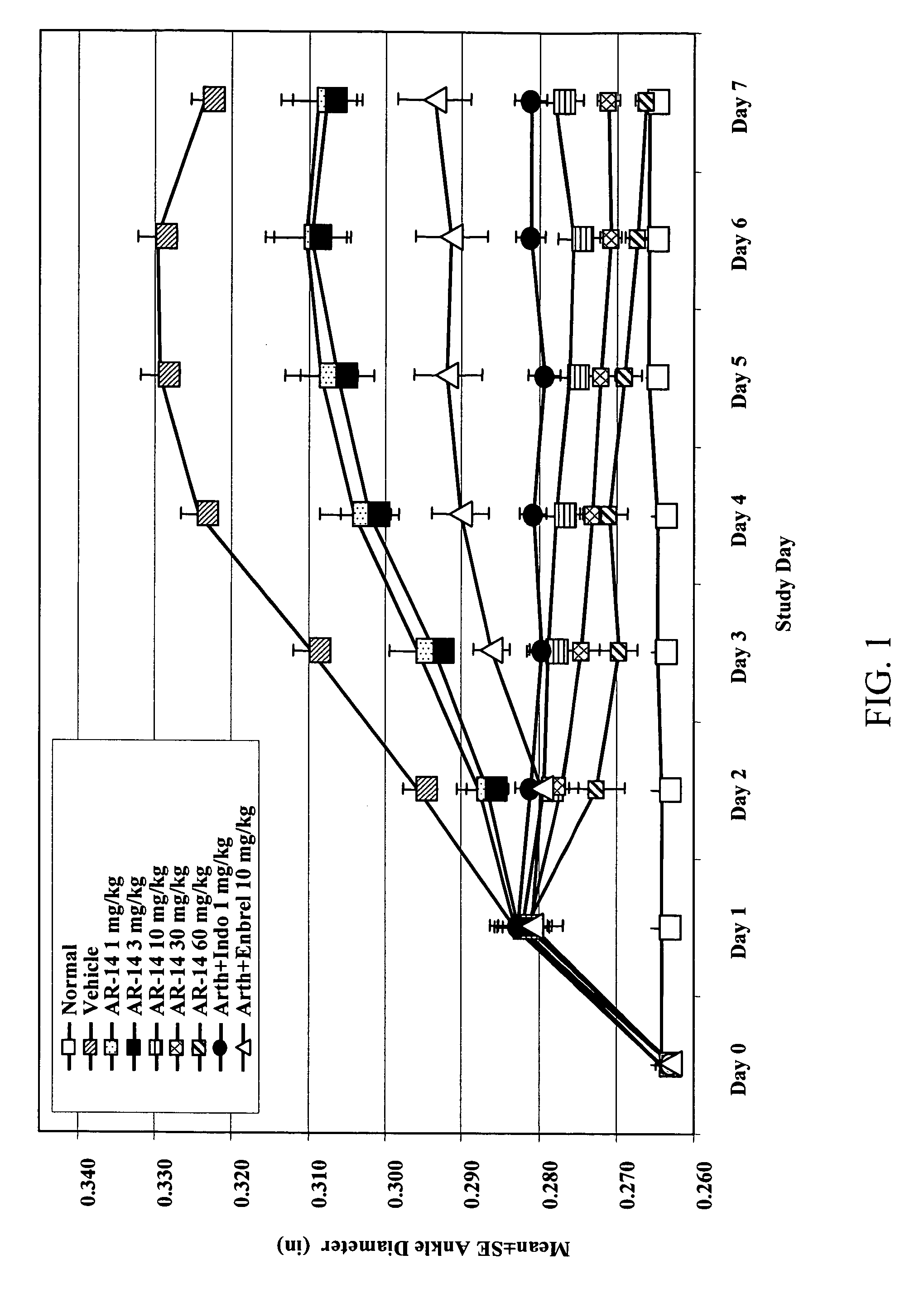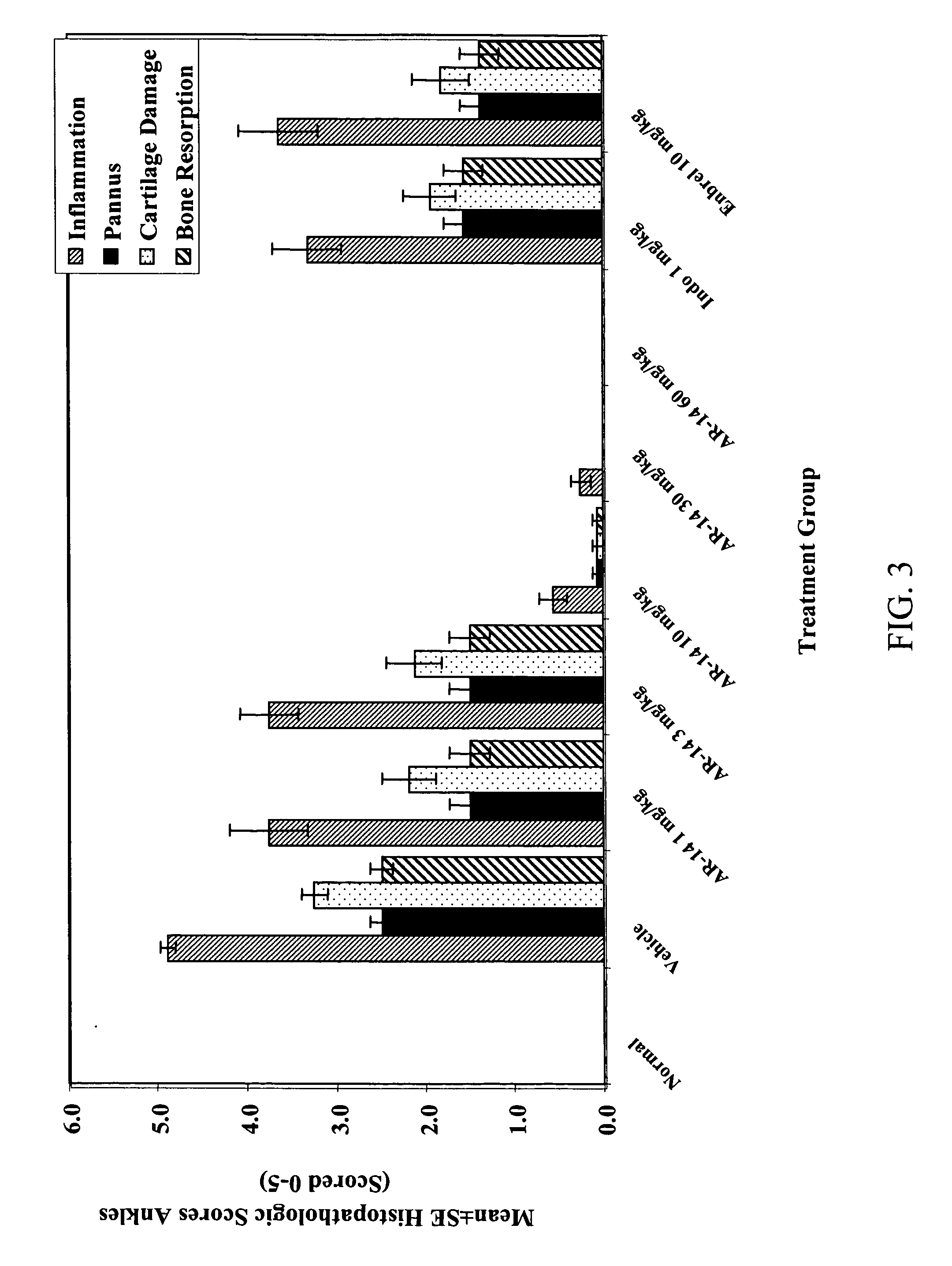Method of treating inflammatory diseases
- Summary
- Abstract
- Description
- Claims
- Application Information
AI Technical Summary
Benefits of technology
Problems solved by technology
Method used
Image
Examples
example 1
[0143]
Synthesis of 6-(4-bromo-2-chlorophenylamino)−7-fluoro-3-methylbenzo[d]isoxazole-5-carboxylic acid (9a)
[0144] Step A: Preparation of 5-bromo-2,3,4-trifluorobenzoic acid (2): To a solution of 1-bromo-2,3,4-trifluorobenzene (1) (5.0 mL, 41.7 mmol) in THF (120 mL) was added LiHMDS (2.0 M solution, 21 mL, 42 mmol) at −78° C. After stirring for 1 hour at −78° C., the mixture was added to a solution of CO2 in THF (1 L). The dry-ice bath was removed and the reaction mixture stirred overnight at room temperature. The reaction mixture was quenched with 10% aqueous HCl (835 mL), concentrated, and washed with ether (250 mL). The combined organics were washed with 5% aqueous NaOH (300 mL) and water (100 mL). The aqueous layer was acidified (pH 0) with concentrated HCl. The resulting suspension was extracted with ether (2×300 mL), dried over MgSO4, filtered, concentrated under reduced pressure to afford 7.70 g (72% yield) of the desired product (2).
[0145] Step B: Preparation of 5-bromo-2-...
example 2
[0152]
Synthesis of 6-(4-bromo-2-chlorophenylamino)−7-fluoro-3-methylbenzo[d]isoxazole-5-carboxylic acid cyclopropylmethoxyamide (10a)
[0153] To a solution of 6-(4-bromo-2-chlorophenylamino)−7-fluoro-3-methylbenzo[d]isoxazole-5-carboxylic acid (9a) (50.0 mg, 0.125 mmol) in DMF (1 mL) was added HOBt (24.6 mg, 0.161 mmol), Et3N (0.060 mL, 0.43 mmol), O-cyclopropylmethyl-hydroxylamine (15.5 mg, 0.178 mmol), and 1-(3-dimethylaminopropyl)−3-ethylcarbodiimide hydrochloride (EDCI) (32.2 mg, 0.168 mmol) at room temperature. After 6 days, the reaction mixture was diluted with EtOAc, washed with saturated aqueous NH4Cl, brine, saturated aqueous NaHCO3, and brine. The organic layer was dried over MgSO4, filtered, concentrated in vacuo, and purified by flash column chromatography using the Biotage system (0.5% MeOH in CH2Cl2) to give 27.6 mg (47% yield) of the desired product (10a). MS APCI (−) m / z 466, 468 (M+, Br, Cl pattern) detected. 1H NMR (400 MHz, CD3OD) δ 7.82 (s, 1H), 7.57 (d, 1H), 7.31...
example 3
[0154]
Synthesis of 6-(4-bromo-2-chlorophenylamino)−7-fluoro-3-methylbenzo[d]isoxazole-5-carboxylic acid (2-hydroxyethoxy)-amide (12a)
[0155] Step A: Preparation of 6-(4-bromo-2-chlorophenylamino)−7-fluoro-3-methyl-benzo[d]isoxazole-5-carboxylic acid (2-vinyloxyethoxy)-amide (11a): To a solution of 6-(4-bromo-2-chlorophenylamino)−7-fluoro-3-methylbenzo[d]isoxazole-5-carboxylic acid (10a) (75.2 mg, 0.188 mmol) in DMF (1.5 mL) was added HOBt (38.2 mg, 0.249 mmol), Et3N (0.080 mL, 0.571 mmol), O-(2-vinyloxyethyl)hydroxylamine (28.5 mg, 0.276 mmol), and EDCI (47.2 mg, 0.246 mmol) at room temperature. After 6 days, the reaction mixture was diluted with EtOAc, washed with saturated aqueous NH4Cl, brine, saturated aqueous NaHCO3, and brine. The organic layer was dried over MgSO4, filtered, concentrated in vacuo, and purified by flash column chromatography using the Biotage system (3% MeOH in CH2Cl2) to give 57.8 mg (63%) of the desired product (11a).
[0156] Step B: Preparation of 6-(4-bromo...
PUM
| Property | Measurement | Unit |
|---|---|---|
| temperature | aaaaa | aaaaa |
| temperature | aaaaa | aaaaa |
| temperatures | aaaaa | aaaaa |
Abstract
Description
Claims
Application Information
 Login to View More
Login to View More - R&D
- Intellectual Property
- Life Sciences
- Materials
- Tech Scout
- Unparalleled Data Quality
- Higher Quality Content
- 60% Fewer Hallucinations
Browse by: Latest US Patents, China's latest patents, Technical Efficacy Thesaurus, Application Domain, Technology Topic, Popular Technical Reports.
© 2025 PatSnap. All rights reserved.Legal|Privacy policy|Modern Slavery Act Transparency Statement|Sitemap|About US| Contact US: help@patsnap.com



